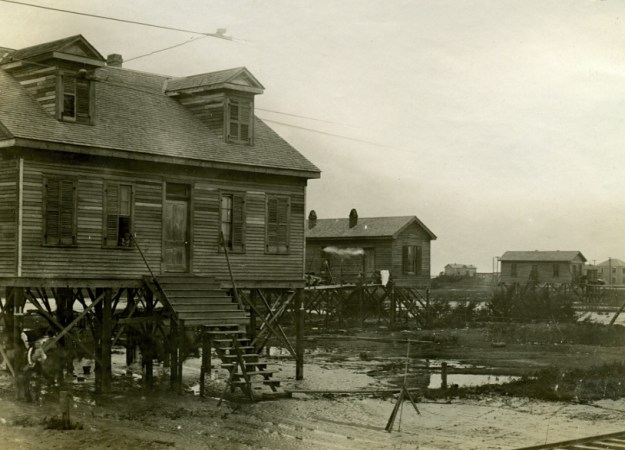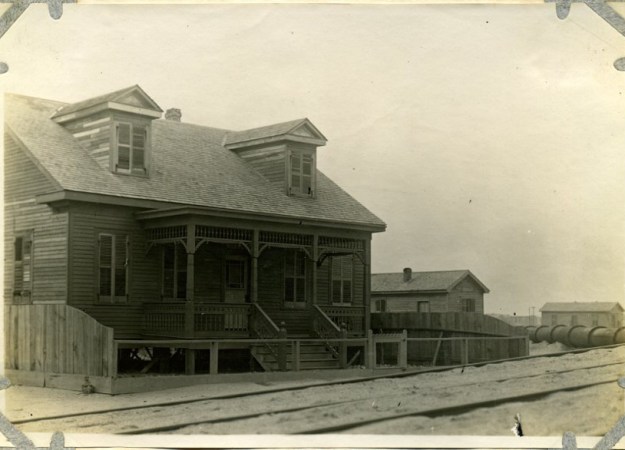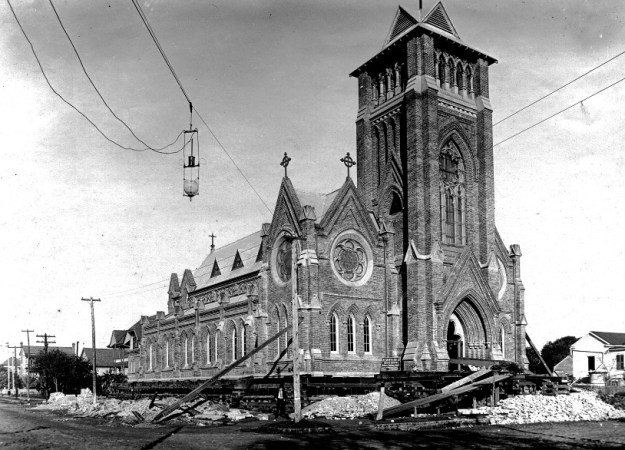To Combat Rising Seas, Why Not Raise Up the Town?
15:34 minutes
When the Great Storm of 1900 battered Galveston, Texas, the town simply lifted itself up—in some places, as much as 17 feet (click on the slideshow above for images from the rebuilding efforts). Could a similar approach save cities today? Randy Behm of the U.S. Army Corps of Engineers and Dwayne Jones of the Galveston Historical Foundation talk about the costs and feasibility of raising a town, albeit with better technology than Galveston’s hand-cranked jacks and mules.

After the Great Storm of 1900 hit Galveston, Texas, thousands of buildings were raised on stilts. Some homeowners took the opportunity to make improvements on their houses and properties. This house, which sits 10 feet in the air, received a new porch and fence. Look closely, and you can see a child peering out of a window while a man (far left, bottom) holds a toddler as he leans against one of the piers supporting the house. Text adapted from Galveston: A City on Stilts, by Jodi Wright-Gidley and Jennifer Marines, Galveston County Museum, p. 68. Courtesy of Galveston County Museum, Galveston, Texas.

The finished house. Courtesy of Galveston County Museum, Galveston, Texas.

St. Patrick’s Catholic Church, located at Thirty-fourth Street and Avenue K in Galveston, Texas, sustained a great deal of damage during the Great Storm of 1900. The tower collapsed through the building, and the interior was ruined. After repairs to the building were made, it was raised five feet using 700 jack screws. One hundred men worked to raise the church, one-half inch at a time, for 35 days. Once the correct height was reached, a new concrete foundation was poured. The H. Sheeler Company of Chicago accomplished the feat without cracking the main walls or damaging the interior. Church services continued throughout the whole process. At 3,000 tons, it was the largest of the 2,156 structures raised during this period. Text adapted from Galveston: A City on Stilts, by Jodi Wright-Gidley and Jennifer Marines, Galveston County Museum, p. 69. Courtesy of Galveston County Museum, Galveston, Texas.
Dwyane Jones is executive director of the Galveston Historical Foundation in Galveston, Texas.
Randy Behm is chairman of the National Nonstructural Flood Proofing Committee for the U.S. Army Corps of Engineers in Omaha, Nebraska.
Christopher Intagliata was Science Friday’s senior producer. He once served as a prop in an optical illusion and speaks passable Ira Flatowese.
| Cookie | Duration | Description |
|---|---|---|
| _abck | 1 year | This cookie is used to detect and defend when a client attempt to replay a cookie.This cookie manages the interaction with online bots and takes the appropriate actions. |
| ASP.NET_SessionId | session | Issued by Microsoft's ASP.NET Application, this cookie stores session data during a user's website visit. |
| AWSALBCORS | 7 days | This cookie is managed by Amazon Web Services and is used for load balancing. |
| bm_sz | 4 hours | This cookie is set by the provider Akamai Bot Manager. This cookie is used to manage the interaction with the online bots. It also helps in fraud preventions |
| cookielawinfo-checkbox-advertisement | 1 year | Set by the GDPR Cookie Consent plugin, this cookie is used to record the user consent for the cookies in the "Advertisement" category . |
| cookielawinfo-checkbox-analytics | 11 months | This cookie is set by GDPR Cookie Consent plugin. The cookie is used to store the user consent for the cookies in the category "Analytics". |
| cookielawinfo-checkbox-functional | 11 months | The cookie is set by GDPR cookie consent to record the user consent for the cookies in the category "Functional". |
| cookielawinfo-checkbox-necessary | 11 months | This cookie is set by GDPR Cookie Consent plugin. The cookies is used to store the user consent for the cookies in the category "Necessary". |
| cookielawinfo-checkbox-others | 11 months | This cookie is set by GDPR Cookie Consent plugin. The cookie is used to store the user consent for the cookies in the category "Other. |
| cookielawinfo-checkbox-performance | 11 months | This cookie is set by GDPR Cookie Consent plugin. The cookie is used to store the user consent for the cookies in the category "Performance". |
| csrftoken | past | This cookie is associated with Django web development platform for python. Used to help protect the website against Cross-Site Request Forgery attacks |
| JSESSIONID | session | The JSESSIONID cookie is used by New Relic to store a session identifier so that New Relic can monitor session counts for an application. |
| nlbi_972453 | session | A load balancing cookie set to ensure requests by a client are sent to the same origin server. |
| PHPSESSID | session | This cookie is native to PHP applications. The cookie is used to store and identify a users' unique session ID for the purpose of managing user session on the website. The cookie is a session cookies and is deleted when all the browser windows are closed. |
| TiPMix | 1 hour | The TiPMix cookie is set by Azure to determine which web server the users must be directed to. |
| viewed_cookie_policy | 11 months | The cookie is set by the GDPR Cookie Consent plugin and is used to store whether or not user has consented to the use of cookies. It does not store any personal data. |
| visid_incap_972453 | 1 year | SiteLock sets this cookie to provide cloud-based website security services. |
| X-Mapping-fjhppofk | session | This cookie is used for load balancing purposes. The cookie does not store any personally identifiable data. |
| x-ms-routing-name | 1 hour | Azure sets this cookie for routing production traffic by specifying the production slot. |
| Cookie | Duration | Description |
|---|---|---|
| __cf_bm | 30 minutes | This cookie, set by Cloudflare, is used to support Cloudflare Bot Management. |
| bcookie | 2 years | LinkedIn sets this cookie from LinkedIn share buttons and ad tags to recognize browser ID. |
| bscookie | 2 years | LinkedIn sets this cookie to store performed actions on the website. |
| lang | session | LinkedIn sets this cookie to remember a user's language setting. |
| lidc | 1 day | LinkedIn sets the lidc cookie to facilitate data center selection. |
| S | 1 hour | Used by Yahoo to provide ads, content or analytics. |
| sp_landing | 1 day | The sp_landing is set by Spotify to implement audio content from Spotify on the website and also registers information on user interaction related to the audio content. |
| sp_t | 1 year | The sp_t cookie is set by Spotify to implement audio content from Spotify on the website and also registers information on user interaction related to the audio content. |
| UserMatchHistory | 1 month | LinkedIn sets this cookie for LinkedIn Ads ID syncing. |
| Cookie | Duration | Description |
|---|---|---|
| __jid | 30 minutes | Cookie used to remember the user's Disqus login credentials across websites that use Disqus. |
| _gat | 1 minute | This cookie is installed by Google Universal Analytics to restrain request rate and thus limit the collection of data on high traffic sites. |
| _gat_UA-28243511-22 | 1 minute | A variation of the _gat cookie set by Google Analytics and Google Tag Manager to allow website owners to track visitor behaviour and measure site performance. The pattern element in the name contains the unique identity number of the account or website it relates to. |
| AWSALB | 7 days | AWSALB is an application load balancer cookie set by Amazon Web Services to map the session to the target. |
| countryCode | session | This cookie is used for storing country code selected from country selector. |
| Cookie | Duration | Description |
|---|---|---|
| _fbp | 3 months | This cookie is set by Facebook to display advertisements when either on Facebook or on a digital platform powered by Facebook advertising, after visiting the website. |
| fr | 3 months | Facebook sets this cookie to show relevant advertisements to users by tracking user behaviour across the web, on sites that have Facebook pixel or Facebook social plugin. |
| IDE | 1 year 24 days | Google DoubleClick IDE cookies are used to store information about how the user uses the website to present them with relevant ads and according to the user profile. |
| NID | 6 months | NID cookie, set by Google, is used for advertising purposes; to limit the number of times the user sees an ad, to mute unwanted ads, and to measure the effectiveness of ads. |
| personalization_id | 2 years | Twitter sets this cookie to integrate and share features for social media and also store information about how the user uses the website, for tracking and targeting. |
| test_cookie | 15 minutes | The test_cookie is set by doubleclick.net and is used to determine if the user's browser supports cookies. |
| vglnk.Agent.p | 1 year | VigLink sets this cookie to track the user behaviour and also limit the ads displayed, in order to ensure relevant advertising. |
| vglnk.PartnerRfsh.p | 1 year | VigLink sets this cookie to show users relevant advertisements and also limit the number of adverts that are shown to them. |
| VISITOR_INFO1_LIVE | 5 months 27 days | A cookie set by YouTube to measure bandwidth that determines whether the user gets the new or old player interface. |
| YSC | session | YSC cookie is set by Youtube and is used to track the views of embedded videos on Youtube pages. |
| yt-remote-connected-devices | never | YouTube sets this cookie to store the video preferences of the user using embedded YouTube video. |
| yt-remote-device-id | never | YouTube sets this cookie to store the video preferences of the user using embedded YouTube video. |
| yt.innertube::nextId | never | This cookie, set by YouTube, registers a unique ID to store data on what videos from YouTube the user has seen. |
| yt.innertube::requests | never | This cookie, set by YouTube, registers a unique ID to store data on what videos from YouTube the user has seen. |
| Cookie | Duration | Description |
|---|---|---|
| _dc_gtm_UA-28243511-20 | 1 minute | No description |
| abtest-identifier | 1 year | No description |
| AnalyticsSyncHistory | 1 month | No description |
| ARRAffinityCU | session | No description available. |
| ccc | 1 month | No description |
| COMPASS | 1 hour | No description |
| cookies.js_dtest | session | No description |
| debug | never | No description available. |
| donation-identifier | 1 year | No description |
| f | never | No description available. |
| GFE_RTT | 5 minutes | No description available. |
| incap_ses_1185_2233503 | session | No description |
| incap_ses_1185_823975 | session | No description |
| incap_ses_1185_972453 | session | No description |
| incap_ses_1319_2233503 | session | No description |
| incap_ses_1319_823975 | session | No description |
| incap_ses_1319_972453 | session | No description |
| incap_ses_1364_2233503 | session | No description |
| incap_ses_1364_823975 | session | No description |
| incap_ses_1364_972453 | session | No description |
| incap_ses_1580_2233503 | session | No description |
| incap_ses_1580_823975 | session | No description |
| incap_ses_1580_972453 | session | No description |
| incap_ses_198_2233503 | session | No description |
| incap_ses_198_823975 | session | No description |
| incap_ses_198_972453 | session | No description |
| incap_ses_340_2233503 | session | No description |
| incap_ses_340_823975 | session | No description |
| incap_ses_340_972453 | session | No description |
| incap_ses_374_2233503 | session | No description |
| incap_ses_374_823975 | session | No description |
| incap_ses_374_972453 | session | No description |
| incap_ses_375_2233503 | session | No description |
| incap_ses_375_823975 | session | No description |
| incap_ses_375_972453 | session | No description |
| incap_ses_455_2233503 | session | No description |
| incap_ses_455_823975 | session | No description |
| incap_ses_455_972453 | session | No description |
| incap_ses_8076_2233503 | session | No description |
| incap_ses_8076_823975 | session | No description |
| incap_ses_8076_972453 | session | No description |
| incap_ses_867_2233503 | session | No description |
| incap_ses_867_823975 | session | No description |
| incap_ses_867_972453 | session | No description |
| incap_ses_9117_2233503 | session | No description |
| incap_ses_9117_823975 | session | No description |
| incap_ses_9117_972453 | session | No description |
| li_gc | 2 years | No description |
| loglevel | never | No description available. |
| msToken | 10 days | No description |